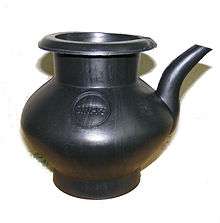Lota (vessel)

A lota (Urdu: لوٹا, Hindi: लोटा, Bengali: লোটা) is a small, usually spherical water vessel of brass, copper or plastic used in parts of South Asia for personal hygiene and, among Muslims, for wudu. [1]
Archaeology
Early examples of Lota and Kindi first appears in chalcolithic period cultures of South Asia, notably in Savalda Culture and two well-preserved examples from Jorwe culture pottery dating back to 2nd millennium BC.[2][3]
Design example
American designer Charles Eames in his The India Report expressed a great admiration for the lota, saying about its design, "Of all the objects we have seen and admired during our visit to India, the Lota, that simple vessel of everyday use, stands out as perhaps the greatest, the most beautiful."[4][5][6]
Yoga and religious uses
The lota is also used in religious activities, like Hindu puja. When used for Hindu worship, it is often decorated with sindoor and/or turmeric powder.
Related concepts
In some parts of Pakistan and India, the use of the phrase "bependi ka lota" (a "lota without a base") is colloquially used to refer to a person who may switch their loyalties. This comes from the observation that a spherical lota without a base tends to roll over in unpredictable directions when kept on uneven ground. The neologism "lotacracy" was coined in Pakistan to describe politicians who would switch parties.[7]
Cleansing
In Islam, the wudu and ghusl ritual purification require water, for which a lota is commonly used.
In the Indian subcontinent, the lota is employed to cleanse oneself.[8] In parts of Bangladesh the term "bodna" describes spouted (teapot-like) vessels. People of the desi diaspora may use watering cans, empty bottles or cups for this purpose. Muslims often refer to the cleansing process as istinja. It is specially use for wudu, bath, vessel and anal cleansing.
This 'bodna' is used by Hindus and called Gangasagar. It is often used for serving water/ sharbat to people in a party or Barat or langar.
See also
References
- ↑ "Definition of Lota". Merriam-Webster's Online Dictionary. Retrieved 2007-03-22.
- ↑ Singh, Upinder (2008). A History of Ancient and Early Medieval India: From the Stone Age to the 12th Century. Delhi: Pearson Education. pp. 229–233. ISBN 978-81-317-1120-0.
- ↑ "Excavations - Important - Maharashtra". Archaeological Survey of India. Retrieved 1 September 2010.
- ↑ Demetrios, Eames (9 February 2002). "An Eames Primer". Universe Publishing. Retrieved 2007-03-22.
- ↑ "Eames' India Report". National Institute of Design, Ahmedabad, India. Retrieved 2007-03-22.
- ↑ "Charles & Ray Eames India Report, April 1958", Design Observer
- ↑ Gauhar, Humayun (24 January 2011). "Blasphemy…or a convenience?". Saudi Gazette. Okaz Organization for Press and Publication. Retrieved 24 January 2011.
- ↑ Donald Albrecht (2009). The Work of Charles and Ray Eames: a Legacy of Invention. Harry N. Abrams. Retrieved 5 September 2011.
India and Pakistan have a water culture, so that it is preferable to use a lota to cleanse with after using the washroom.
External links
| Wikimedia Commons has media related to Lota (vessel). |
- Bodna Nai Music video depicting the extinction of the Bodna from Urban Bangladesh
- The Lota Blog A comedic blog about the use and application of the lota in modern times
- Nuevos Habitos An artist dedicated to Lota and other stuff